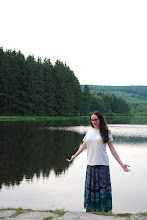Woodley Park/Adams Morgan is a versatile area. For example, did you know there's an art gallery just across the street from the metro stop? The Stanford University in Washington hosts this hidden treasure of an art space. The current exhibit, of which the ending date has been extended until May 2nd, 2011, is the fourth 'THIS for diplomats; Festival des Artistes; Diplomacy through Art' exhibit.
The website for the gallery can be found here:
http://bsiw.stanford.edu/art_
What caught my eye from the street was a case displaying jewelry; as I am a jewelry artist, I was naturally drawn to see it. The jewelry is displayed in bird's nests, as if the pieces were eggs laid by birds. The dull color of the sticks in the nest accentuate the shiny baubles elegantly. Some are wire wrapped around glass, attached to wire circlets; others are intricate woven patterns done with seed beads.
An Indonesian artist presented a series of five pieces constructed with thick handmade paper called 'hanji.' A bit of research tells me that 'hanji' is a traditional material from Korea. Two of the pieces serve as lamps: one appears to be graceful flowers which spring forth jubilantly from a black pumpkin-shape; the other lamp more closely resembles a pagoda roof in its tiered succession of layers which hug the wall. The center and top-tier of the pagoda lamp from which the light emanates is a light-colored paper screen, with detailed symbols and figures on it. The greatest success of this piece from my perspective as a sculptor, is that the light shows not only from behind the paper screen, but also to each side of it, illuminating the wider tiers as well. It is very rare that a work of art lights itself perfectly on all sides as this one does.
Also on display are some incredible oil paintings from Switzerland and Israel. A similarity between these three works from two artists, is their clarity and use of light. The edges seem solid and round, the feathers soft, the porcelain cold, the broken egg dripping down lace…
Now that I've mentioned porcelain, I could not leave out the painted porcelain which is displayed just below these works in oil. The perfectly formed vases and plates round out the collection of art. One particularly lovely plate displays intricate butterflies.
On my first visit, I was particularly impressed by a painting from Iraq. The subject is a woman holding a letter. With her other hand she leans on a flowering tree. She appears to be alone for miles in every direction. Her head is bare and her tawny robes drape around her with grace. The turbid purple sky adds an unearthly element to the sandy yet lush landscape. This painting brought tears to my eyes, possibly because it removed a misconception I hadn't realized I had until then; that the Middle East is colorless. The news media pound it into our heads repeatedly that Iraq is a dismal, desert area with no visual interest. This piece of art so successfully countered the media's repetition that it leads me to wonder whether this is merely an imagined view of a war-torn country, a memory of past days, or if our own country has censored what we see to the point where I cannot actually find a single lovely picture of the landscape when using the word 'Iraq' on google images.
This was the essence of the exhibit, for me, the removal of boundaries between cultures. The gallery's own statement that "art connects those from around the world and builds international understanding," underscores all the work in the collection. From the jewelry to the 'hanji' sculptures, to the paintings and photographs, each spoke of cultural blending and an incorporated experience of aesthetics. Each piece left me wanting details of the person's life, made me wonder whom they know and what they discuss with their friends, what they do for fun. The goal of every artist should be to present a work so evocative of their own experience that viewers can't help but feel they are investigating a mystery.
Perhaps I'll leave a few works for you to discover for yourself! When you visit the gallery, exit the metro from the escalators, not the elevator. Turn left at the top and cross Connecticut Avenue. You will pass a florist's shop and an Italian restaurant before the gallery. Remember, there are more works up the stairs!
I found a really interesting video on how hanji is made: http://vimeo.com/1729477?pg=
It's actually pretty hypnotizing when he's dipping the bamboo screen.
May be posted on http://soulstrong.wordpress.com/ as well!!
